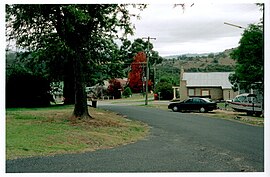| Wyangala New South Wales | |||||||||
|---|---|---|---|---|---|---|---|---|---|
 Wyangala village, looking towards St Vincent's Church (permanently closed), corner of Waugoola and Wirong Rds. | |||||||||
| Coordinates | 33°57′S 148°59′E / 33.950°S 148.983°E | ||||||||
| Population | 216 (SAL 2021)[1] | ||||||||
| Postcode(s) | 2808 | ||||||||
| Elevation | 341 m (1,119 ft)[2] | ||||||||
| Location | |||||||||
| LGA(s) | Cowra Shire | ||||||||
| County | King County | ||||||||
| State electorate(s) | Cootamundra | ||||||||
| Federal division(s) | Hume | ||||||||
| |||||||||
Wyangala /ˈwaɪæŋɡɑːlə/ is a small village in the Lachlan Valley, near the junction of the Abercrombie and Lachlan Rivers, just below the Wyangala Dam wall. It is in the South West Slopes of New South Wales, Australia, and about 320 km (200 mi) west of the state capital, Sydney. The name is also used for the surrounding rural locality, which includes the site of the former mining village of Mount McDonald.
The village was named after an indigenous word of unknown meaning, thought to be of Wiradjuri origin. The Wiradjuri were the original inhabitants of the Lachlan Valley, with campsites along river flats, on open land and by rivers. Their traditional way of life was altered, and perhaps lost, following the exploration of the valley by British explorers, John Oxley and George William Evans in 1815. White settlement followed in the 1830s, leading to violent clashes between the Wiradjuri and the settlers.
The present-day village was established in 1928, during the construction of Wyangala Dam. However, in the same area, there was a scattered pioneering settlement known as Wyangala Flats, which was established in the 1840s. This settlement was submerged under water following the completion of Wyangala Dam in 1935.
Although Wyangala grew substantially during periods of dam construction, the population dwindled in the subsequent years. This resulted in the removal of houses and the closure of most businesses, leaving Wyangala with a small primary school, a Catholic church (permanently closed), sports fields and parks, in addition to other facilities. There are no buildings of historical note, as the original purpose of the village was to solely provide utilitarian accommodation for the construction workers.
Attractions in the area include Lake Wyangala (used for power generation, water-sports and fishing activities), a nine-hole golf course, walking and mountain bike trails, and the 1.37 km (0.85 mi) long dam wall itself. Wyangala has a warm and temperate climate with a diverse range of native and exotic plants and animals, including threatened and endangered species. The flora, fauna and village residents occupy a hilly landscape dominated by granite, with large rock outcrops and boulders throughout the entire area.
- ^ Australian Bureau of Statistics (28 June 2022). "Wyangala (suburb and locality)". Australian Census 2021 QuickStats. Retrieved 28 June 2022.
- ^ "Elevation of 12 13 Winga Road Wyangala NSW 2808". elevationmap.net. Archived from the original on 17 May 2014. Retrieved 1 May 2014.
